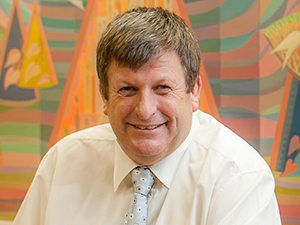
[miningmx.com] – Graham Briggs, the outgoing CEO of Harmony Gold, tackled the question of who was to succeed him by saying it was probably tough for the company’s board to find someone “crazy enough” to accept the post.
Enter Peter Steenkamp, formerly Harmony’s chief operating officer before leaving for other pastures. His appointment as Briggs’ replacement is, therefore, something of a home-coming.
Ironically, one of Steenkamp’s first tasks at Harmony will be to find a new COO following the departure of Alwyn Pretorius who quit the firm only two months after Briggs announced his retirement plans in June.
The mid-year period was a tough time for Harmony because it had seen its share price fall a quarter in a month amid painful restructuring at the Doornkop and Kusasalethu mines, as well as project curtailments and impairments the previous year at the Phakisa and Target mines.
Briggs told Miningmx, however, that that period of restructuring had been a turning point, and Harmony was now able to survive the slide in the dollar gold price; a development considered likely if US jobs figures give the Federal Reserve the confidence to raise rates.
“The restructuring has taken alot of management time, but we are over that … barring anything changing dramatically from external factors,” said Briggs. “We’ve also gone through wage negotiations in a positive manner.”
UBS analyst, Kane Slutzkin, said Harmony’s recent September quarter results suggested “… a potential inflection point” for the share in which Harmony’s management could translate stronger rand prices for gold of over R500,000 per kilogram into improved cash flow.
In the main, however, the view from analysts was more cautious. “Our initial read is that this business remains in trouble,” said Richard Hart of Arqaam Capital. “While weakness of the rand may assist in containing US dollar cost inflation, it is wreaking havoc on the balance sheet,” he said.
The company produced free cash from last quarter’s outflow, but it tapped R300m of a Nedbank revolving credit facility following a draw down of a dollar-denominated revolver in the previous quarter which translated into R541m in debt.
“This company is presently unable to fund its entire capital expenditure bill from operating cashflows and will continue to require the assistance of its debt facilities,” said Hart.
That’s not the opinion of Briggs, however.
He told Miningmx Harmony could zap its R2.5bn debt pile in two years now the restructuring was finished. He also disagreed with a note from Goldman Sachs which suggested Harmony had under-invested in its assets. “We haven’t been shy on capex,” he said. “We haven’t been starving our operations.”
The plan now is that in knocking out debt, the company will be in a position to fund Golpu, a copper and gold prospect in Papua New Guinea it shares equally with Australian gold miner Newcrest Mining.
In a sense, Golpu is Harmony’s purpose with the South African gold mines providing the headroom to finance it. “If you go back five years we have spent R2bn to R2.2bn on Golpu which has come out of South African generated cash. We get criticised for not paying dividends, but Golpu is very important for the company,” he said.
A feasibility study on the first phase of the mine detailing production and costs is due for December with its official unveiling most likely one of the first things that Steenkamp will do in January. Based on previous studies, Harmony’s share of Golpu’s capital cost has been put at $800m. This means it must still stump up $600m after the cash the company has already put in.
But can the South African mines support the balance sheet so long? No, believes Goldman Sachs which has been withering of Harmony’s performance in the past. “Despite the strong results, we remain bearish on the stock,” the bank said.
“Harmony’s mines are old and have been under-invested. In our view, to make the mines profitable will require significant investment which we believe the gold price and Harmony’s balance sheet weakness do not allow,” it said.
In fact, net debt would rise from R2.2bn to R3.8bn by the end of Harmony’s 2018 financial year. “As such, we do not see a deleveraging, hence we think that Golpu project remains questionable,” it added.
“Harmony announced a number of restructuring measures over the past year. We see limited scope for further restructuring and believe that any restructuring would need to be accompanied by reducing staff costs which is a challenge in South Africa,” said Goldman Sachs.
If this view is born out over time, one wonders whether it would have made better sense for Harmony to be conjoined with another gold producer along the lines of the big bang consolidation voiced by Sibanye Gold CEO, Neal Froneman.
In fact, there was speculation several months ago that Harmony’s major shareholder, African Rainbow Minerals, led by executive chairman,Patrice Motsepe ,had turned down an offer for it shares in Harmony from Sibanye – scuttlebug that Briggs said he could not support.
“It didn’t come that close,” said Briggs. “You always have to look at these things as part of the job but we did not have a discloseable offer on the table,” he added.
Over now to Steenkamp.
Formerly of Pamodzi Gold, the company that attempted to breathe new life into the East Rand and Orkney gold mines with disastrous results (although not directly of Steenkamp’s making), Steenkamp is faced with executing Briggs’ Brave New World for Harmony.
“He has more than thirty years’ experience in the mining industry and should lead Harmony to greater heights,” said Motsepe, notably using the modal verb – should – a reflection perhaps of doubts in Harmony that its critics share.








